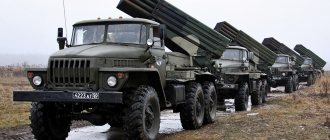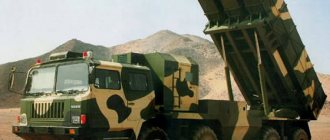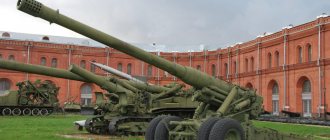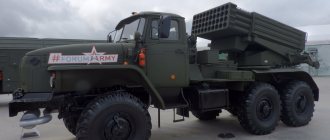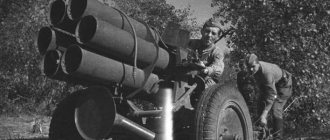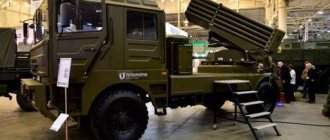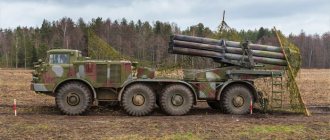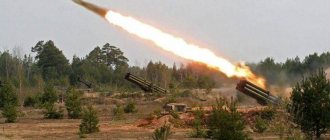The 9K57 Uragan MLRS is a Soviet multiple launch rocket system developed in the 70s. It is still used by the Russian army. The main task of this weapon is to defeat enemy personnel and other targets at distances from 10 to 35 km. The Uragan MLRS can be used to remotely lay anti-personnel and anti-tank mines.
The development of the complex was carried out by the Tula State Research and Production Enterprise "Splav", which previously created another famous rocket system - "Grad". Work on the creation of the 9K57 Uragan MLRS was led by General Designer Ganichev.
In terms of its main characteristics, the Uragan significantly surpassed the B-21 Grad: it is more powerful, has a longer firing range and can use a wider range of ammunition, which increases the versatility of this weapon.
The Uragan MLRS is in service with several dozen countries around the world; it has taken part in many conflicts and has repeatedly proven its high efficiency.
History of creation
In the mid-60s, the Soviet military received the excellent Grad MLRS, which at that time had no analogues in any of the armies in the world. However, the military needed another MLRS complex with slightly different characteristics: with a longer firing range and more powerful ammunition. Since 1963, the designers of the State Research and Production Enterprise “Splav” have proactively worked on the creation of such a MLRS. In 1967, a preliminary design of the system was ready, bench tests of various components were carried out, and experimental missiles were fired.
In 1972, field testing of the Hurricane and refinement of the rocket system began. At this stage, the designers were able to obtain the characteristics that the military required of them. The firing range of the new MLRS reached 35 km, its accuracy was significantly increased (it is 1.5 higher than that of the Grad) and the effectiveness of hitting the enemy. A salvo from one launcher covered an area of 42 hectares.
The designers of "Splav" were the first in the world to create a cluster warhead for a rocket launcher for MLRS. Since then, several types of cluster munitions have been developed for the Uragan; in addition to ammunition with fragmentation warheads, the missile can be equipped with anti-tank and anti-personnel mines.
In 1975, the Hurricane was put into service, and its production continued until 1991.
Afghanistan became the Hurricane's baptism of fire; Soviet troops widely used this MLRS throughout the conflict. The Uragan also took part in combat operations in Africa; the Syrian army used it against Israeli troops in the early 80s, and Russian federal troops used it in both Chechen campaigns. The 9K57 Uragan MLRS was actively used by both sides of the conflict in eastern Ukraine.
Operators
- Belarus Belarus - 72 units 9P140, as of 2016
- Guinea Guinea - 3 units of 9P140, as of 2016, a total of 4 Uragan MLRS were delivered
- Kazakhstan Kazakhstan - 180 units of 9P140 in storage, as of 2016
- Kyrgyzstan Kyrgyzstan - 6 units 9P140, as of 2016
- Moldova Moldova - 11 units 9P140, as of 2016
- Russia Russia - 900 units of 9P140, of which 700 are in storage, as of 2016
- Syria Syria - a certain number of 9P140, as of 2016, 36 units of 9P140 were supplied from the USSR between 1987 and 1988
- Turkmenistan Turkmenistan - 60 units of 9P140, as of 2016, according to Motovilikha Plants OJSC, only 54 Uragan MLRS were delivered
- Ukraine Ukraine - 70 units of 9P140, as of 2016, a total of 139 Uragan MLRS delivered
- Uzbekistan Uzbekistan - 48 units 9P140, as of 2016
- Eritrea Eritrea - 9 units 9P140, as of 2016. Delivered in 2007 from Belarus
According to some reports, 11 units were delivered from Moldova to Armenia in 2011. However, according to other sources, 12 Moldovan 9K57 complexes were delivered to Yemen in 1994, while 9K57 Uragan MLRS were not supplied to Armenia from Moldova or any other countries; as of 2014, from MLRS systems Armenia has only BM-21 and WM-80 in service.
Former operators
- Afghanistan Afghanistan - a certain number of 9P140, as of 2010, a total of 18 Uragan MLRS were delivered
- Iraq Iraq - a total of 24 Uragan MLRS delivered
- Yemen Yemen - a total of 12 Uragan MLRS have been delivered. Deliveries were made from Moldova in 1994.
- Tajikistan Tajikistan - 12 MLRS "Uragan" as part of military unit PP 11121 201st Motorized Rifle Division of the Russian Armed Forces. Currently, military unit 11121 has been disbanded, all MLRS have been redistributed to unit 201 of the Russian military base in the Republic of Tajikistan.
Description
The Uragan MLRS includes the following components:
- 9P140 combat vehicle;
- rockets;
- transport-charging machine;
- fire control complex;
- meteorological complex;
- educational equipment;
- car for topographic survey.
The main component of the Hurricane is the 9P140 combat vehicle, based on the ZIL-135LM vehicle with an 8x8 wheel arrangement. The artillery part consists of sixteen tubular guides, which are combined into a single package. The guides are mounted on a rectangular platform - a cradle. The swinging part is installed on a rotating base, which ensures azimuth alignment of the guides. Guidance is also possible using a manual drive.
Aiming in the vertical plane is possible in the range from +6° to +55°. The horizontal guidance angle ranges from – 30° to +30° from the longitudinal axis of the vehicle. Jacks are installed in the rear of the car, which increase stability when shooting.
The Hurricane is equipped with a panoramic sight and gun panorama, a walkie-talkie and a night vision device.
The tubular guides have a U-shaped groove, with the help of which the missile is given a rotational movement.
Shooting can be carried out either in one volley or in single shots. A variant of the so-called ragged salvo is possible, during which the first eight missiles are fired at intervals of 0.5 seconds, and the remaining eight - 2 seconds. The time of a regular salvo is 8.8 seconds, and a “ragged” salvo is 20. Firing can be carried out from the cockpit or remotely. The firing range reaches 35 km; if fire is fired at shorter distances, then special brake rings are installed on the head of the missile.
The ZIL-135LM car is equipped with two eight-cylinder engines with a power of 180 hp. With. every. The power plant is located behind the cab. The wheels of the rear and front axles are steerable, the machine is equipped with a tire inflation system.
A similar chassis is used for the transport-charging vehicle. It can carry up to 16 rockets. Loading can be carried out without special preparation, at any site, its time is 15 minutes. The transport-loading vehicle is equipped with a crane, a tray with a rammer, cargo trolleys, docking devices, electrical equipment and an alignment mechanism.
The simplest and most used type of rocket for the Uragan MLRS is the 9M27F with a high-explosive fragmentation warhead. The ammunition consists of a warhead and a rocket part. The warhead and fuse are located in the head part, and the solid propellant engine and stabilizers are located in the missile part. They (like those of the Grad) have the shape of a cylinder sector and open after the missile leaves the guide.
The Uragan 9M27K MLRS missile has a cluster warhead containing thirty fragmentation elements. They are located in five sections of six around the axis of the projectile. Each such element is equipped with its own stabilizers and contains 350 ready-made submunitions with high penetrating ability.
"Hurricane" became the first multiple launch rocket system that could be used for remote mining of terrain. At a given altitude, the warhead of the rocket is revealed by a powder charge, and the warheads are scattered over a certain area. The fuse of each mine is blocked by a delay system, which turns off after the ammunition lands. After this, the mines are put on combat duty.
As combat elements, the Uragan missile can carry anti-tank contact mines (explodes only after hitting them) and mines that react to the magnetic field of the combat vehicle. The latter have cumulative notches and can penetrate tank armor.
Also, the warhead of the missile can be equipped with PFM-1S anti-personnel mines (312 pieces). This mine has a plastic body and a small wing, which is designed to disperse ammunition over a large area. They are shaped like a butterfly or petal. Such mines were widely used by Soviet troops in Afghanistan, and the civilian population, especially children, suffered greatly from them.
The rocket can also be equipped with a volumetric detonating warhead.
Combat use
The 9K57 MLRS was widely used in combat operations in Afghanistan.
It was used by the Russian armed forces, with the support of the Northern Alliance forces, in Afghanistan in 1993-1998.
Used by Russian armed forces during the first and second wars in Chechnya.
It was also used by the Russian Armed Forces during the Armed Conflict in South Ossetia in 2008.
Hurricanes were widely used during the Armed Conflict in eastern Ukraine by both sides.
The 9K57 MLRS was used by the Syrian Arab Army during the Civil War in Syria (for example, during the liberation of Palmyra). Also, according to some reports, the Uragan was used by the Russian armed forces.
Technical characteristics of the 9K57 Uragan MLRS
Below are the tactical and technical characteristics of the Uragan multiple launch rocket system.
| Characteristics of the combat vehicle | |
| Number of guides | 16 |
| Charged mass with calculation, t | 20 |
| Weight without shells and crew, t | 15,1 |
| Vertical aiming angle (firing zone), degrees | +6…+55 |
| Maximum guidance speed for electric drives, deg/s | 3 |
| Minimum guidance speed for electric drives, deg/s | 0,2 |
| Full salvo time, s: | |
| at a constant pace | 8,8 |
| at a “ragged” pace | 20 |
| Firing range, km: | |
| maximum | 35,8 |
| minimum | 5 |
| Time, min: | |
| transfer from traveling to combat position | 3 |
| loading | 14 |
| preparation for emergency relocation | 1,5 |
| Chassis | Zil-135LM |
| Chassis weight, t | 10,6 |
| Dimensions, m: | |
| in a stowed position | 9.63x2.8x3.23 |
| in combat position | 10.83x5.34x5.24 |
| Maximum speed, km/h | 65 |
| Cruising range, km | 570 |
| Fording depth, m | 1,2 |
| Calculation of peacetime/wartime, persons | 4 (6) |
Ammunition Specifications
| Characteristics of rockets | |||||
| Index | MS type | Weight, kg | MS mass, kg | Length | Firing range, km |
| 9M27F | high-explosive fragmentation | 280 | 99 | 4833 | 10-35,8 |
| 9M27K | cassette, fragmentation | 271 | 89,5 | 5178 | 7,5-35 |
| 9M27K2 | anti-tank mining | 271 | 89,5 | 5178 | Jul.34 |
| 9M27K3 | anti-personnel mining | 271 | 89,5 | 5178 | Jul.34 |
| 9M51 | volume-detonating | 256 | 143,5 | 5147 | May.13 |
| 9M59 | anti-tank mining | 270 | 90 | 5178 | Oct.35 |
Modernization
MLRS “Smerch” - 9A52-2: The firing range increased from 70 to 90 km, the combat crew decreased from 4 to 3 people, the automation of the system increased, namely, topographical location began to be carried out automatically via satellite systems.
The latest generation MLRS, the Tornado, is currently being created at the Splav enterprise. It will be double-caliber, combining Hurricane and Smerch on one platform. Automation of firing will reach such a level that the installation will be able to leave the position even before the projectile reaches the target. “Tornado” will be able to hit targets both in a salvo and with single high-precision missiles, and in fact, will become a universal tactical missile system.
At the MAKS-2007 aerospace show it is planned to show the latest package-type launcher based on a four-axle KAMAZ all-wheel drive chassis with 6 missile guides instead of 12. The introduction of a special system allows dispersed crews to conduct coordinated fire. The main goal of the modernization is to increase the mobility of the complex by reducing weight and dimensions. It is understood that this will expand export opportunities.
More about Bat.-Châtillon Bourrasque
The French word bourrasque translates as a sudden, sharp gust of wind. These features are fully inherent in the new tank - fast and merciless, like a hurricane. The Bat.-Châtillon Bourrasque boasts excellent mobility and fast acceleration, as well as the ability to quickly change flanks or get behind an unsuspecting enemy.
Small dimensions and good camouflage allow the tank to literally sneak up on the target. Equipped with a cannon with a 2-round magazine, the Bat.-Châtillon Bourrasque can deal 720 damage in a couple of seconds and speed away. But after a reload of 22 seconds, it is again ready to mercilessly sting the enemy. This tank is perfect for fans of an aggressive and assertive playing style.
